Prediction Method for High-Speed Laser Cladding Coating Quality Based on Random Forest and AdaBoost Regression Analysis
Abstract
:1. Introduction
2. Experimental Design
2.1. Experimental Equipment and Materials
2.2. Experimental Principle
2.3. Experimental Design
2.4. Experimental Method
3. Model for Predicting the Quality of the Cladding Layer
3.1. Establishment of Prediction Model
3.1.1. The RF Model
- A training set with n samples was selected from the high-speed laser cladding parameter combination sample set using the Bootstrap method. The selected samples were used to train a decision tree as the sample of the decision tree node.
- m features were randomly selected from the 6 features of the sample, satisfying the condition m << 6. Then, 1 feature was chosen from the m features as the splitting feature of the node; steps 1 to 2 were repeated 100 times, where 100 is the number of decision trees in the RF.
- The trained RF was used to predict the test sample, and the prediction result was obtained using the voting method.
3.1.2. The AB Model
- m samples were selected from the 25 sample sets of high-speed laser cladding as a training set D, D = ((x1, y1), (x2, y2), …, (xm, ym)).
- A sampling weight D1(x) = wj was assigned to each training sample, with the initial wj = 1/m, i = 1. A training set was generated by sampling with replaceability, with an equal volume and weight. A weak learner was assigned for each training round, and the weight of the weak learner was calculated.
- Weak learners were combined into a strong learner: ).
3.2. Tests and Results
4. Importance Evaluation and Prediction Model Verification
4.1. Evaluation of the Importance of High-Speed Laser Cladding Process Parameters
4.2. Verification of High-Speed Laser Cladding Coating Quality Using the AB Prediction Model
5. Conclusions
- (1)
- The prediction process of high-speed laser cladding coating quality is complicated, and the RF and AB algorithms have strong mapping ability and nonlinear relationships. Therefore, when solving complex multivariate nonlinear problems, they can be adopted to address the issue of high-precision fitting, which is difficult for multiple-regression analysis, thereby achieving effective prediction of cladding quality. The AB prediction model captures volatile data points, and it is more accurate and more sensitive to abnormal data (maximum or minimum) than the RF in the prediction of multiple response values.
- (2)
- The AB algorithm was also used to evaluate the importance of process parameters during the training of the learner. The most effective method to change the height and surface roughness of the cladding layer is to adjust the scanning speed. On the other hand, the overlap rate is the most important factor for controlling the dilution ratio and near-surface grain size of high-speed laser cladding. Alongside that, the microhardness of the coating and the thermal effect of the substrate can be effectively enhanced by adjusting the laser power and scanning speed. These observations provide a basis for the adjustment of process parameters in the stability control of the melting process.
- (3)
- The experimental results indicate that the prediction errors of the AB model on the response values of cladding layer height, molten pool depth, dilution ratio, grain size, surface roughness and microhardness are all less than 6%. Therefore, the quality of the high-speed laser cladding layer can be predicted by this prediction model during machining. The prediction results indicate that the application of machine learning methods based on the AB algorithm has a certain reference value and practical significance in parameter prediction and performance optimization of the high-speed laser cladding process. It provides a new idea for the process parameter control in high-speed laser cladding.
Author Contributions
Funding
Institutional Review Board Statement
Informed Consent Statement
Data Availability Statement
Conflicts of Interest
References
- Aladesanmi, V.I.; Fatoba, O.S.; Jen, T.C.; Akinlabi, E.T. Microstructural Characteristics and Hardness Property of Laser Cladded Ti and TiB2 Nanocomposites on Steel Rail. In Proceedings of the IEEE 12th International Conference on Mechanical and Intelligent Manufacturing Technologies (ICMIMT), Cape Town, South Africa, 13–15 May 2021. [Google Scholar] [CrossRef]
- Zeuner, A.T.; Gerdt, L.; Ostwald, A.; Grün, P.; Barbosa, M.; Kaspar, J.; Zimmermann, M. Deformation-Induced Martensitic Transformation in Laser Cladded 304 Stainless Steel Coatings. Materials 2022, 15, 6392. [Google Scholar] [CrossRef]
- Borhani, M.R.; Rajabi, M.; Shojarazavi, R.; Jamaati, R. Statistical modeling in the laser cladding process of Inconel 625 via linear regression and response surface method. J. Laser Appl. 2023, 35, 022024. [Google Scholar] [CrossRef]
- Yamashita, Y.; Nakamura, M.; Sakai, M.; Kunimine, T.; Sato, Y.; Funada, Y.; Tsukamoto, M. In Situ Evaluation of Crack Generation Using Acoustic Emission Technique during Laser Cladding of WC-Co Cemented Carbide via Multi-Beam Laser Metal Deposition. Mater. Sci. Forum 2023, 1083, 153–158. [Google Scholar] [CrossRef]
- Schopphoven, T.; Gasser, A.; Wissenbach, K.; Poprawe, R. Investigations on ultra-high-speed laser material deposition as alternative for hard chrome plating and thermal spraying. J. Laser Appl. 2016, 28, 022501. [Google Scholar] [CrossRef]
- Brucki, M.; Schmickler, T.; Gasser, A.; Häfner, C.L. Influence of the Relative Position of Powder–Gas Jet and Laser Beam on the Surface Properties of Inconel 625 Coatings Produced by Extreme High-Speed Laser Material Deposition (EHLA). Coatings 2023, 13, 998. [Google Scholar] [CrossRef]
- Lampa, C.; Smirnov, I. High speed laser cladding of an iron based alloy developed for hard chrome replacement. J. Laser Appl. 2019, 31, 022511. [Google Scholar] [CrossRef]
- Li, L.; Shen, F.; Zhou, Y.; Tao, W. Comparative study of stainless steel AISI 431 coatings prepared by extreme-high-speed and conventional laser cladding. J. Laser Appl. 2019, 31, 042009. [Google Scholar] [CrossRef]
- Asghar, O.; Li-Yan, L.; Yasir, M.; Chang-Jiu, L.; Cheng-Xin, L. Enhanced Tribological Properties of LA43M Magnesium Alloy by Ni60 Coating via Ultra-High-Speed Laser Cladding. Coatings 2020, 10, 638. [Google Scholar] [CrossRef]
- Ilanlou, M.; Shoja, R.R.; Nourollahi, A.; Hosseini, S.; Haghighat, S. Prediction of the geometric characteristics of the laser cladding of Inconel 718 on the Inconel 738 substrate via genetic algorithm and linear regression. Opt. Laser Technol. 2022, 156, 0030–3992. [Google Scholar] [CrossRef]
- Izumi, T.; Arai, M. Numerical simulation of the 3D propeller repair process by laser cladding of SUS316L on SUS304. J. Manuf. Process. 2023, 98, 234–253. [Google Scholar] [CrossRef]
- Nazemi, N.; Urbanic, J. An Experimental and Simulation Study for Powder Injection Multitrack Laser Cladding of P420 Stainless Steel on AISI 1018 Steel for Selected Mechanical Properties. J. Manuf. Sci. Eng. 2018, 140, 011009. [Google Scholar] [CrossRef]
- Doležel, I.; Kotlan, V.; Hamarand, R.; Slobodnik, K. Modelling the Laser Cladding of Geometrically More Complex Tracks and Its Experimental Verification. Metals 2021, 11, 1403. [Google Scholar] [CrossRef]
- Kumar, A.; Roy, S. Effect of three-dimensional melt pool convection on process characteristics during laser cladding. Comput. Mater. Sci. 2009, 46, 495–506. [Google Scholar] [CrossRef]
- Chai, Q.; Fang, C.; Qiu, X.; Xing, Y.; Sun, G.J.S.; Technology, C. Modeling of temperature field and profile of Ni60AA formed on cylindrical 316 stainless steel by laser cladding. Surf. Coat. Technol. 2021, 428, 127865. [Google Scholar] [CrossRef]
- Mazzarisi, M.; Campanelli, S.L.; Angelastro, A.; Dassist, M. Phenomenological modelling of direct laser metal deposition for single tracks. Int. J. Adv. Manuf. Technol. 2020, 111, 1955–1970. [Google Scholar] [CrossRef]
- Zhao, L.; Yue, H.; Guo, C.; Li, Q.; Hao, G. Analytical modelling and experimental study of the cladding characteristics of a laser powder-fed additive manufacturing process. Int. J. Adv. Manuf. Technol. 2020, 109, 2891–2900. [Google Scholar] [CrossRef]
- Fathi, A.; Toyserkani, E.; Khajepour, A.; Durali, M. Prediction of melt pool depth and dilution in laser powder deposition. J. Phys. D Appl. Phys. 2006, 39, 2613–2623. [Google Scholar] [CrossRef]
- García-Moreno, A.-I.; Alvarado-Orozco, J.-M.; Ibarra-Medina, J.; Martínez-Franco, E. Ex-situ porosity classification in metallic components by laser metal deposition: A machine learning-based approach—ScienceDirect. J. Manuf. Process. 2021, 62, 523–534. [Google Scholar] [CrossRef]
- Menghani, J.; More, S.; Vyas, A.; Patnaik, A.; Paul, C. Parametric investigation and optimization for CO2 laser cladding of AlFeCoCrNiCu powder on AISI 316. High Temp. Mater. Process. 2021, 40, 265–280. [Google Scholar] [CrossRef]
- Khorram, A.; Jamaloei, A.D.; Paidar, M.; Cao, X. Laser cladding of Inconel 718 with 75Cr3C2 + 25(80Ni20Cr) powder: Statistical modeling and optimization. Surf. Coat. Technol. 2019, 378, 124933. [Google Scholar] [CrossRef]
- Khorram, A.; Taheri, M.; Fasahat, M. Laser cladding of Inconel 713 LC with Stellite 31 powder: Statistical modeling and optimization. Laser Phys. 2021, 31, 096001. [Google Scholar] [CrossRef]
- Zhu, Q.; Liu, Z.; Yan, J. Machine learning for metal additive manufacturing: Predicting temperature and melt pool fluid dynamics using physics-informed neural networks. Comput. Mech. 2021, 67, 619–635. [Google Scholar] [CrossRef]
- Le, X.; Hao, J.; Meng, Q.; Hu, F.; Liu, X. Prediction of 18Ni300 laser cladding topography based on back-propagation neural network and particle swarm optimization. J. Phys. 2021, 1775, 012009. [Google Scholar] [CrossRef]
- Deng, Z.; Chen, T.; Wang, H.; Li, S.; Liu, D. Process Parameter Optimization When Preparing Ti(C, N) Ceramic Coatings Using Laser Cladding Based on a Neural Network and Quantum-Behaved Particle Swarm Optimization Algorithm. Appl. Sci. 2020, 10, 6331. [Google Scholar] [CrossRef]
- Chen, T.; Wu, W.; Li, W.; Liu, D. Laser cladding of nanoparticle TiC ceramic powder: Effects of process parameters on the quality characteristics of the coatings and its prediction model. Opt. Laser Technol. 2019, 116, 345–355. [Google Scholar] [CrossRef]
- Zhao, H. Optimization of Multi-Track Laser-Cladding Process of Titanium Alloy Based on RSM and NSGA-II Algorithm. Coatings 2022, 12, 1301. [Google Scholar] [CrossRef]
- Gao, J.; Wang, C.; Hao, Y.; Wang, X.; Zhao, K.; Ding, X. Prediction of molten pool temperature and processing quality in laser metal deposition based on back propagation neural network algorithm. Opt. Laser Technol. 2022, 155, 108363. [Google Scholar] [CrossRef]
- Breiman, L. Random forests. Mach. Learn. 2001, 45, 5–32. [Google Scholar] [CrossRef]
- Angel-Ivan, G.-M.; Juan-Manuel, A.-O.; Juansethi, I.-M.; Enrique, M.-F. Image-based porosity classification in Al-alloys by laser metal deposition using random forests. Int. J. Adv. Manuf. Technol. 2020, 110, 2827–2845. [Google Scholar] [CrossRef]
- Valle, C.; Ñanculef, R.; Allende, H.; Moraga, C. LocalBoost: A Parallelizable Approach to Boosting Classifiers. Neural Process. Lett. 2019, 50, 19–41. [Google Scholar] [CrossRef]
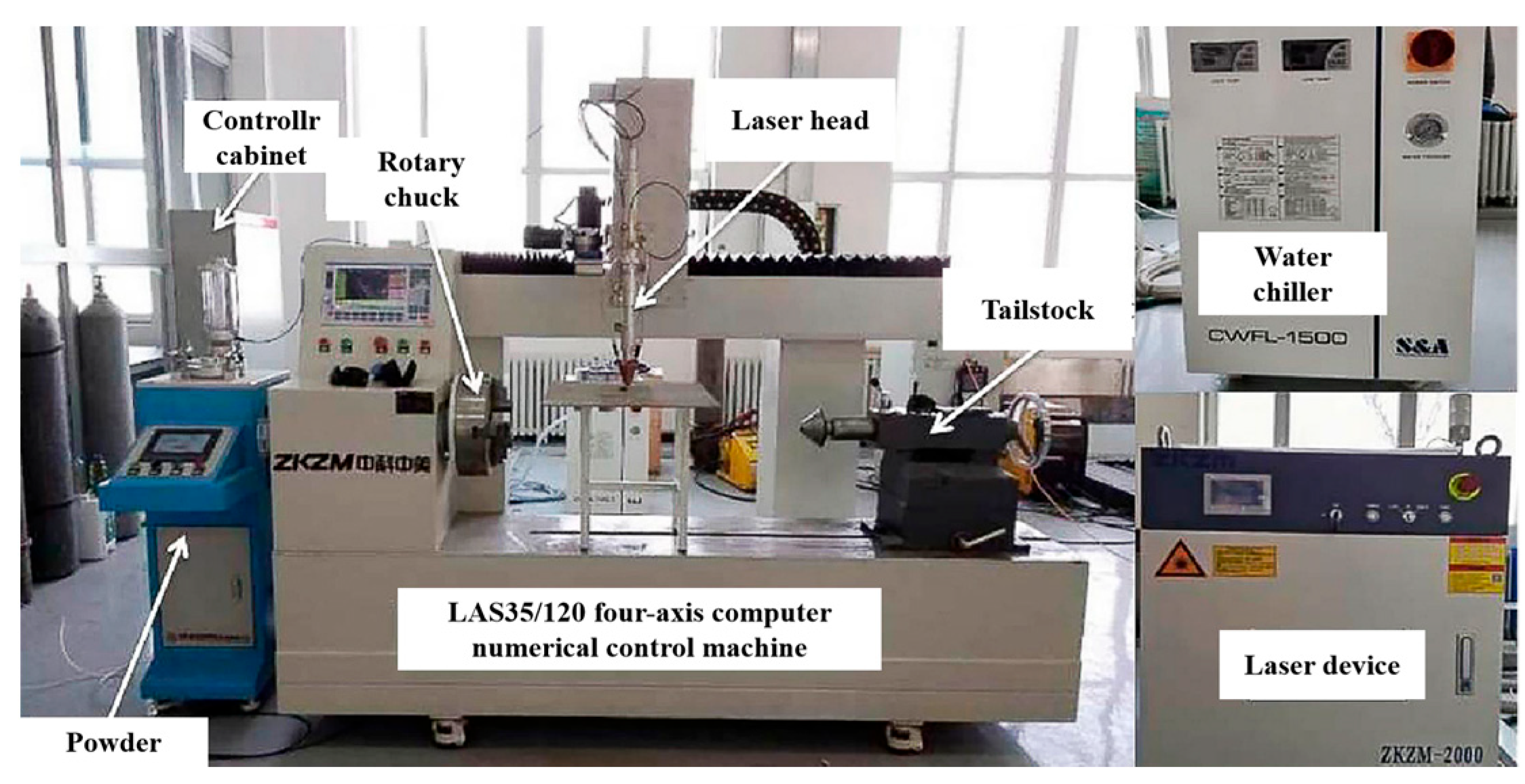
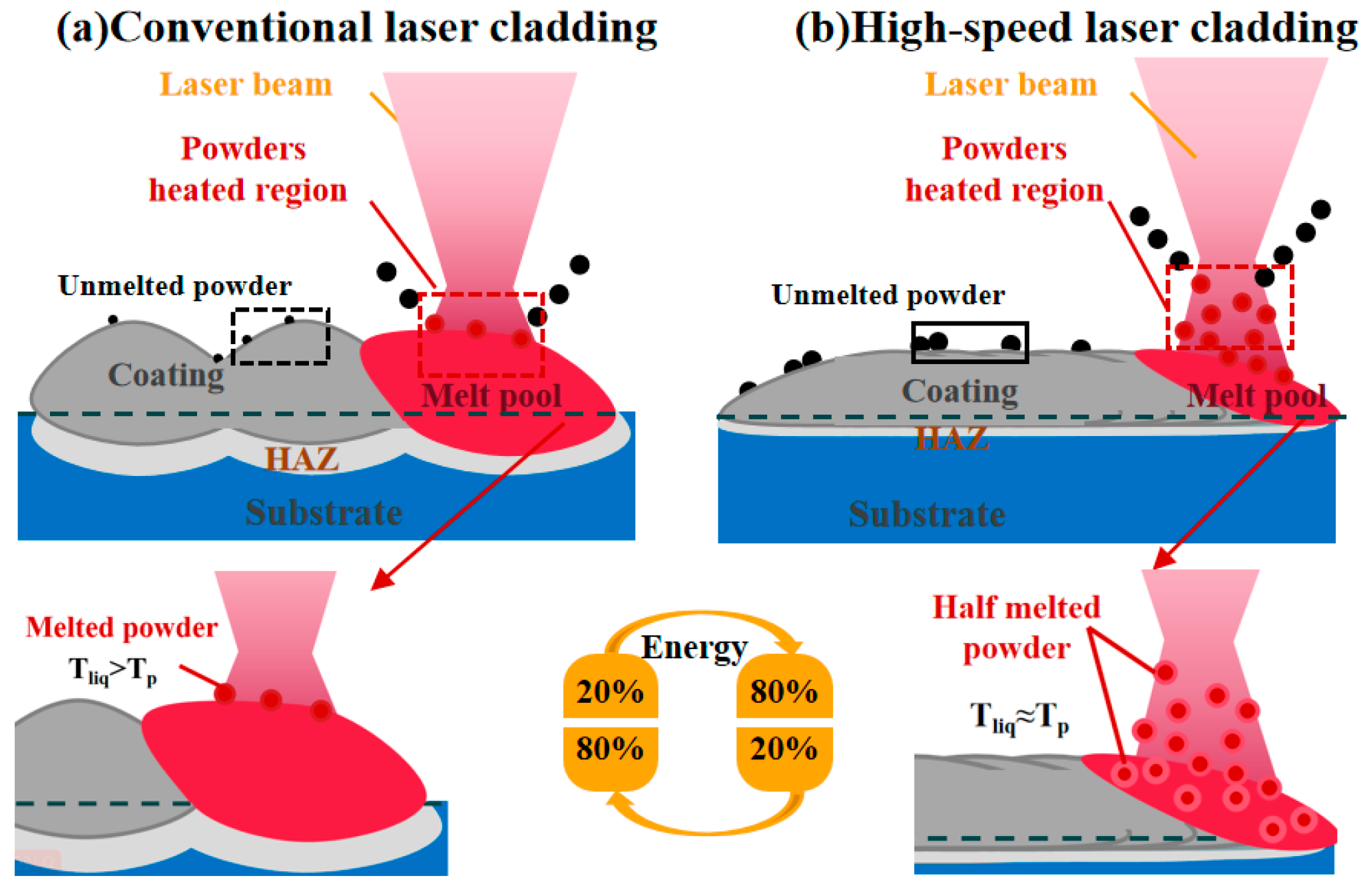
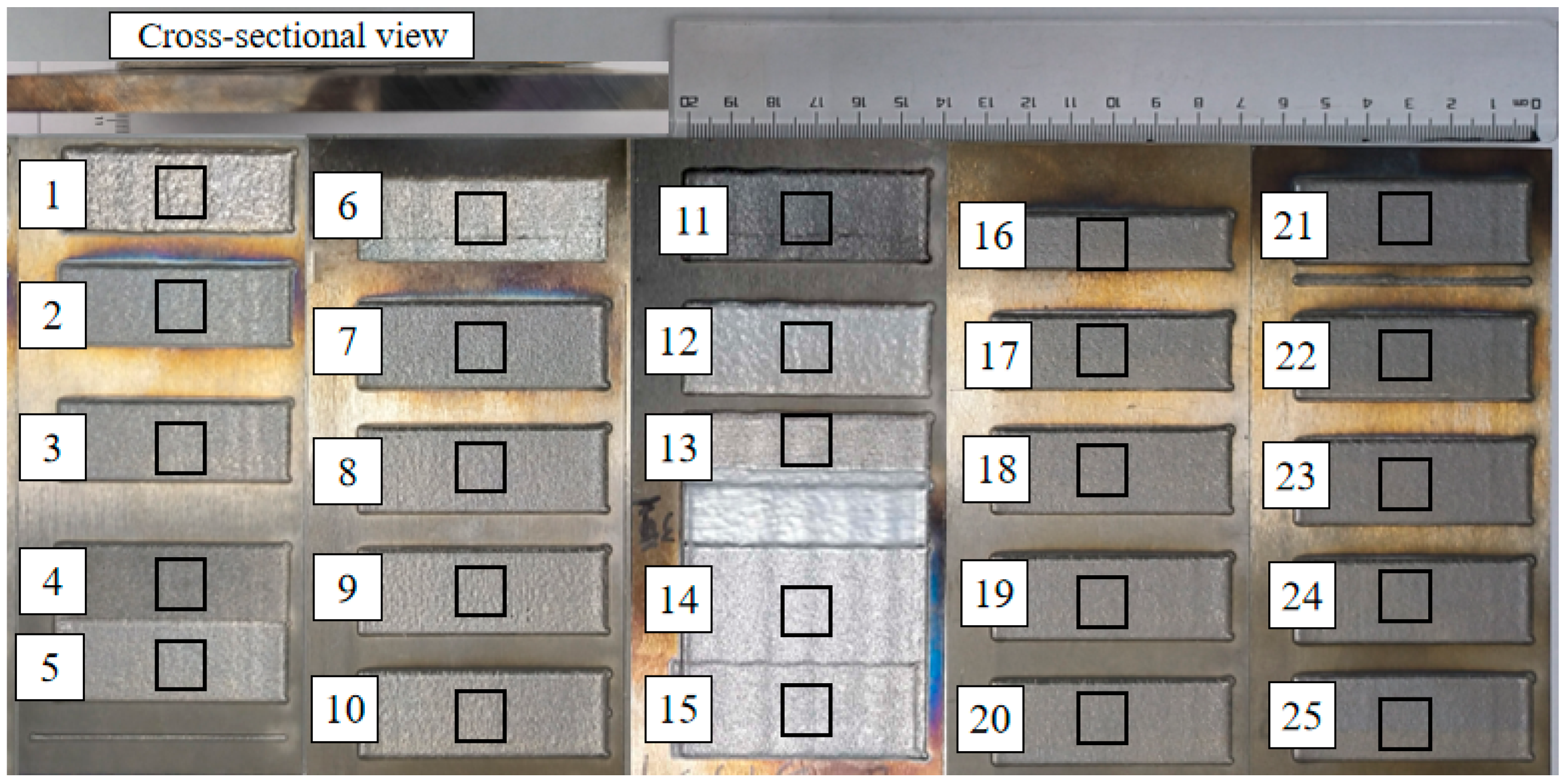

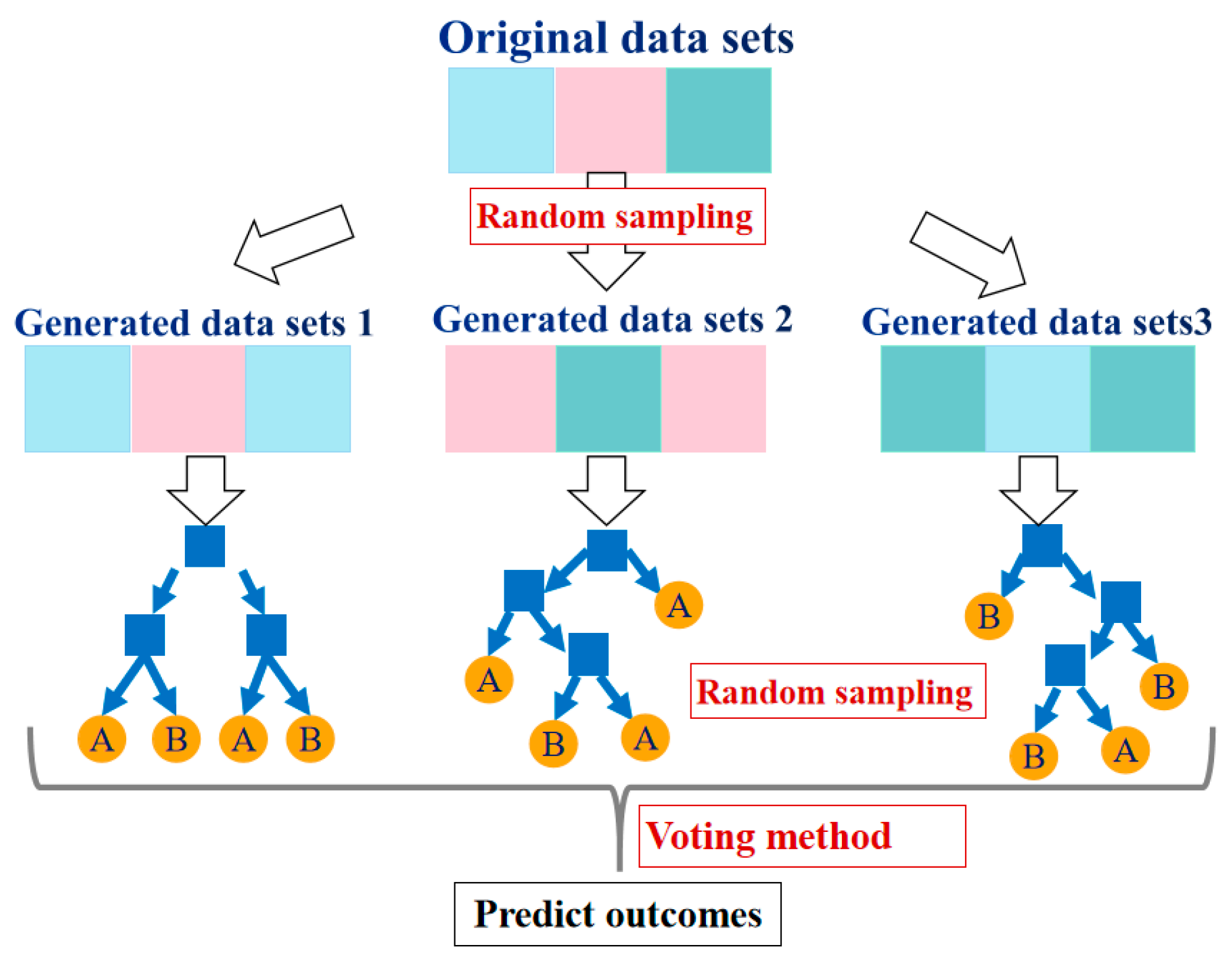

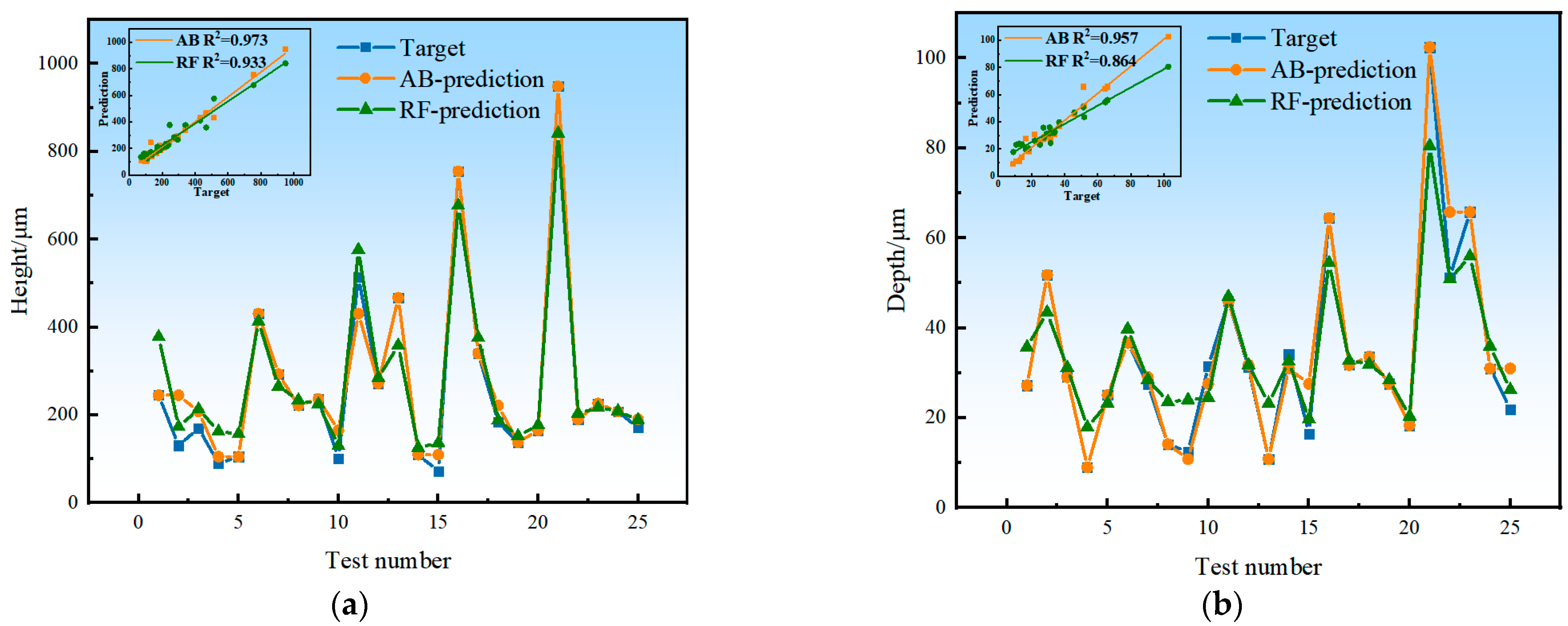
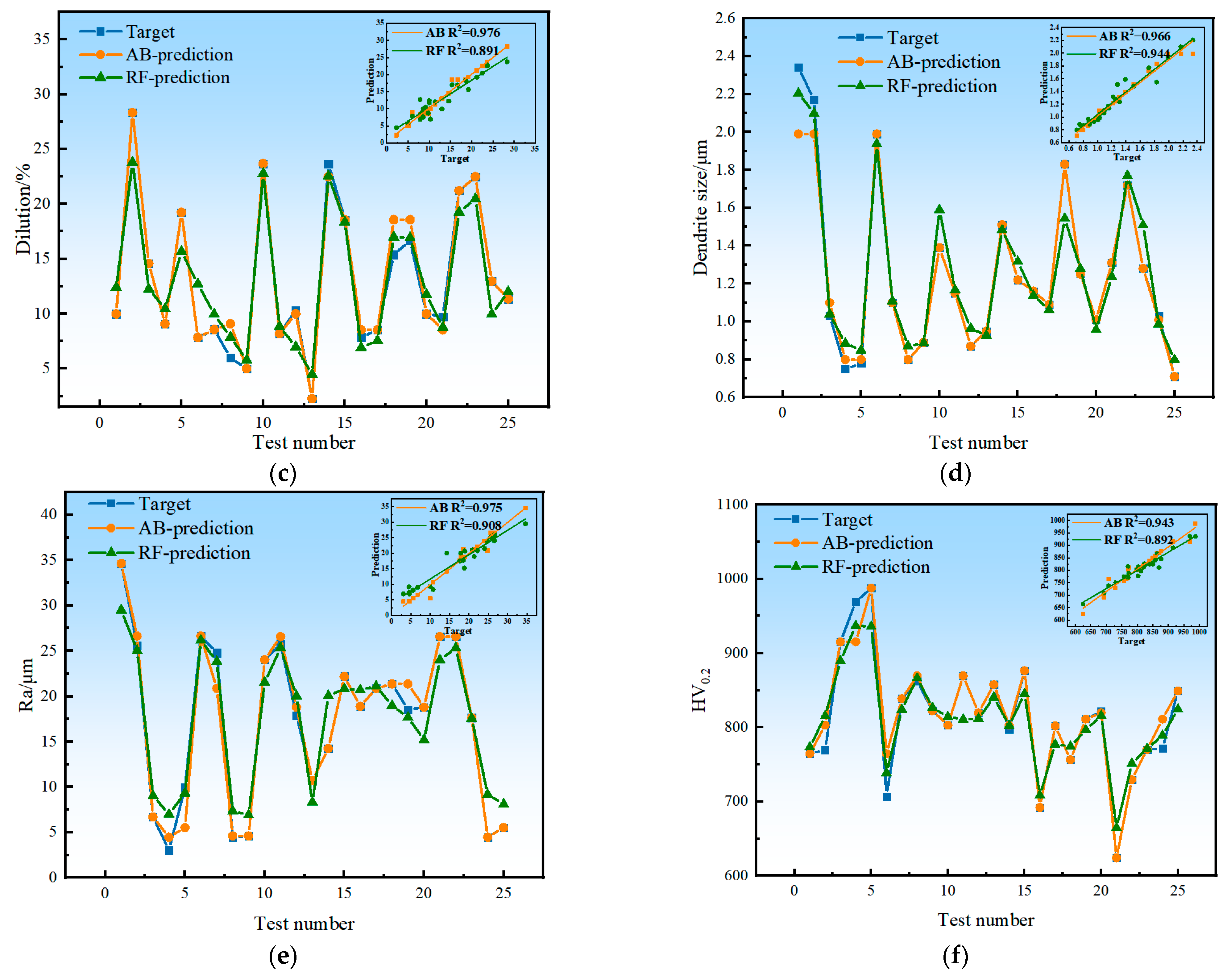
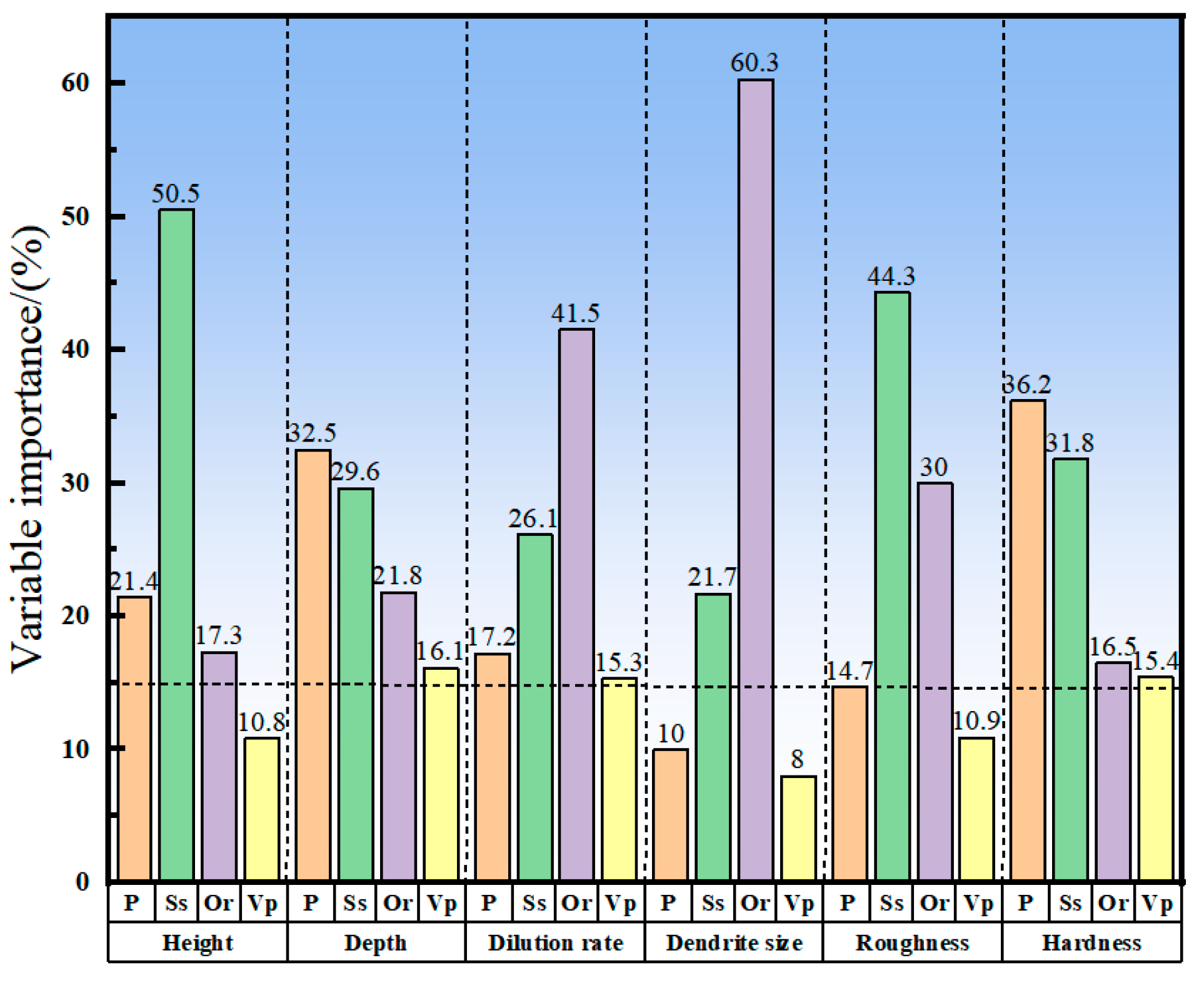
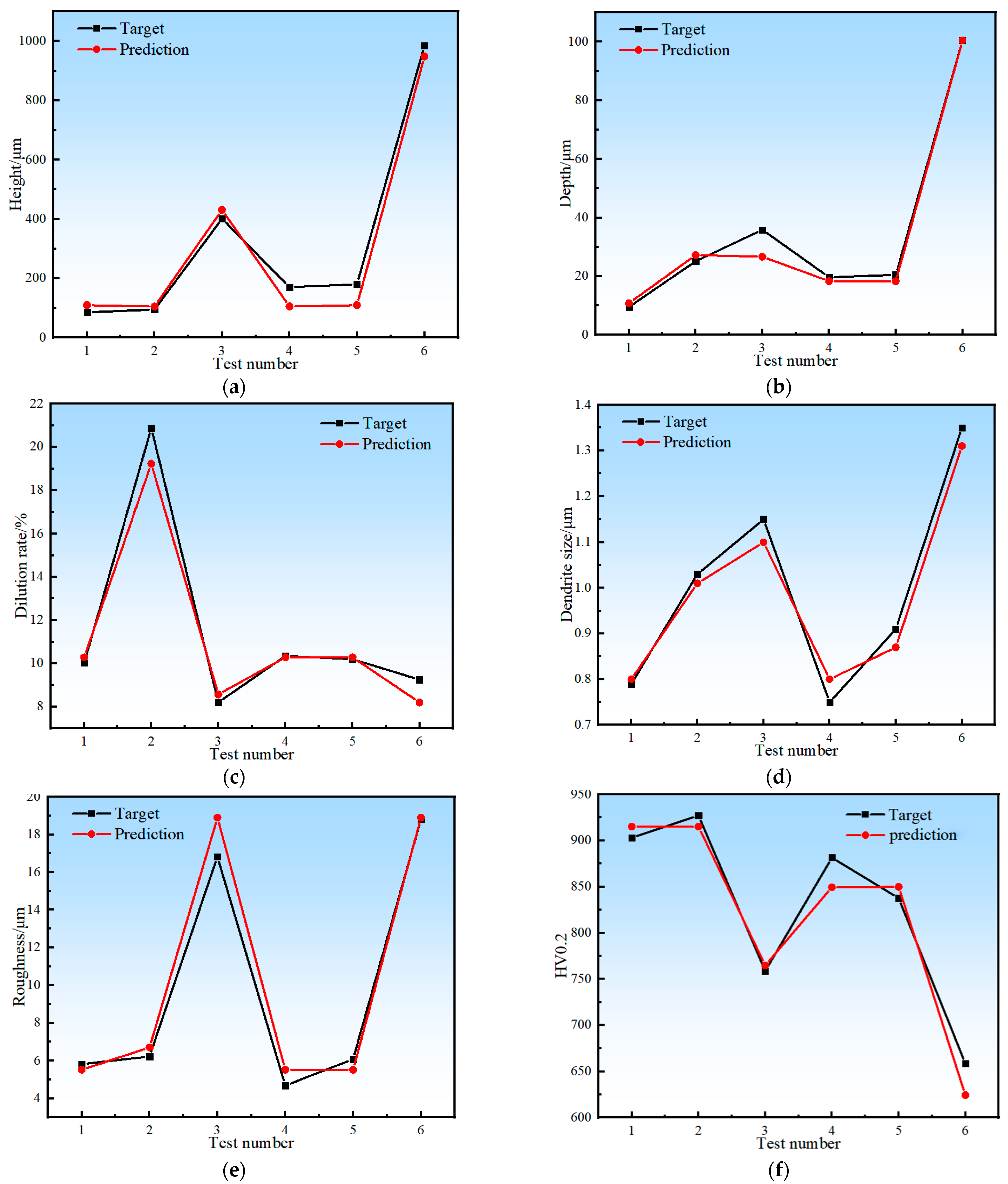
| Parameter Type | Inversion |
|---|---|
| Power | 500–2000 W |
| Wave length | 1080 nm |
| Spot diameter | 1.2 mm |
| Powder feeding method | Three-way coaxial powder feeding |
| Scanning speed | 0–20 m |
| Gas flow | 20–25 L/min |
| Maximum spindle speed | 200 r/min |
| Machine stroke (X-axis) | 3222 mm |
| Machine stroke (Y-axis) | 400 mm |
| Machine stroke (Z-axis) | 300 mm |
| Chemical Composition | C | Si | Cr | Ni | Mo | B | Fe |
| Value (wt.%) | 0.15 | 4.5 | 22 | 13 | 2 | 1.6 | Bal. |
| No. | Laser Power/ | Scanning Speed/ | Overlap Ratio/ | Powder Flow Rate/ |
|---|---|---|---|---|
| P (W) | Ss (mm/min) | Or (%) | Vp (r/min) | |
| 1 | 660 | 3600 | 20 | 2.5 |
| 2 | 880 | 7200 | 35 | 3 |
| 3 | 1100 | 10,800 | 50 | 3.5 |
| 4 | 1320 | 14,400 | 65 | 4 |
| 5 | 1540 | 18,000 | 80 | 4.5 |
| No. | Process Parameter | Response | ||||||||
|---|---|---|---|---|---|---|---|---|---|---|
| Laser Power/ | Scanning Speed | Overlap Ratio | Powder Feeding Rate | Height | Depth | Dilution Rate | Grain Size | Roughness | Hardness | |
| P (W) | Ss (mm/min) | Or (%) | Vp (r/min) | H (μm) | D (μm) | H (%) | Ds (μm) | Ra (μm) | HV0.2 | |
| 1 | 660 | 3600 | 20 | 2.5 | 245.15 | 27.24 | 10 | 2.34 | 34.63 | 764.83 |
| 2 | 660 | 7200 | 35 | 3 | 131.01 | 51.8 | 28.33 | 2.17 | 25.63 | 769.87 |
| 3 | 660 | 10,800 | 50 | 3.5 | 170.3 | 29.07 | 14.58 | 1.03 | 6.71 | 915.10 |
| 4 | 660 | 14,400 | 65 | 4 | 90.29 | 9.03 | 9.09 | 0.75 | 3.03 | 969.22 |
| 5 | 660 | 18,000 | 80 | 4.5 | 105.51 | 25.12 | 19.23 | 0.78 | 9.96 | 987.57 |
| 6 | 880 | 3600 | 35 | 3.5 | 431.22 | 36.7 | 7.84 | 1.99 | 26.63 | 707.07 |
| 7 | 880 | 7200 | 50 | 4 | 293.37 | 27.5 | 8.57 | 1.1 | 24.8 | 838.93 |
| 8 | 880 | 10,800 | 65 | 4.5 | 222.01 | 14.17 | 6 | 0.8 | 4.49 | 862.75 |
| 9 | 880 | 14,400 | 80 | 2.5 | 237.17 | 12.48 | 5 | 0.89 | 4.62 | 822.71 |
| 10 | 880 | 18,000 | 20 | 3 | 101.63 | 31.54 | 23.68 | 1.39 | 24.05 | 803.18 |
| 11 | 1100 | 3600 | 50 | 4.5 | 514.41 | 45.92 | 8.2 | 1.15 | 25.75 | 869.69 |
| 12 | 1100 | 7200 | 65 | 2.5 | 272.33 | 31.25 | 10.29 | 0.87 | 17.9 | 819.93 |
| 13 | 1100 | 10,800 | 80 | 3 | 467.05 | 10.86 | 2.27 | 0.95 | 10.75 | 857.91 |
| 14 | 1100 | 14,400 | 20 | 3.5 | 109.78 | 34.1 | 23.68 | 1.51 | 14.26 | 797.77 |
| 15 | 1100 | 18,000 | 35 | 4 | 72.38 | 16.51 | 18.57 | 1.22 | 22.2 | 876.60 |
| 16 | 1320 | 3600 | 65 | 3 | 755.01 | 64.45 | 7.87 | 1.16 | 18.9 | 692.25 |
| 17 | 1320 | 7200 | 80 | 3.5 | 340.56 | 31.79 | 8.54 | 1.09 | 20.89 | 802.23 |
| 18 | 1320 | 10,800 | 20 | 4 | 184.97 | 33.63 | 15.38 | 1.83 | 21.38 | 756.58 |
| 19 | 1320 | 14,400 | 35 | 4.5 | 137.86 | 27.57 | 16.67 | 1.25 | 18.55 | 811.26 |
| 20 | 1320 | 18,000 | 50 | 2.5 | 165.23 | 18.36 | 10 | 1.01 | 18.82 | 822.14 |
| 21 | 1540 | 3600 | 80 | 4 | 948.57 | 102.4 | 9.75 | 1.31 | 26.57 | 624.48 |
| 22 | 1540 | 7200 | 20 | 4.5 | 190.51 | 51.29 | 21.21 | 1.72 | 26.57 | 729.75 |
| 23 | 1540 | 10,800 | 35 | 2.5 | 226.66 | 65.8 | 22.5 | 1.28 | 17.65 | 770.49 |
| 24 | 1540 | 14,400 | 50 | 3 | 208.09 | 31 | 12.96 | 1.03 | 4.49 | 771.56 |
| 25 | 1540 | 18,000 | 65 | 3.5 | 171.21 | 21.95 | 11.36 | 0.71 | 5.53 | 849.48 |
| No. | Process Parameter | Response | ||||||||
|---|---|---|---|---|---|---|---|---|---|---|
| Laser Power/ | Scanning Speed | Overlap Ratio | Powder Feeding Rate | Height | Depth | Dilution Rate | Grain Size | Roughness | Hardness | |
| P (W) | Ss (mm/min) | Or (%) | Vp (r/min) | H (μm) | D (μm) | H (%) | Ds (μm) | Ra (μm) | HV0.2 | |
| 1 | 660 | 14,400 | 65 | 3.5 | 85.78 | 9.57 | 10.04 | 0.79 | 5.83 | 903.29 |
| 2 | 660 | 18,000 | 50 | 4.5 | 95.35 | 25.15 | 20.87 | 1.03 | 6.23 | 927.11 |
| 3 | 880 | 3600 | 65 | 2.5 | 401.57 | 35.9 | 8.21 | 1.15 | 16.82 | 758.64 |
| 4 | 880 | 18,000 | 65 | 3.5 | 170.66 | 19.7 | 10.35 | 0.75 | 4.69 | 881.57 |
| 5 | 1100 | 18,000 | 65 | 3.5 | 180.59 | 20.51 | 10.20 | 0.91 | 6.09 | 837.64 |
| 6 | 1540 | 3600 | 80 | 3 | 985.15 | 100.5 | 9.25 | 1.35 | 18.82 | 658.49 |
| Model | Height (H) | Depth (D) | Dilution (η) | ||||||
|---|---|---|---|---|---|---|---|---|---|
| MAE | RMSE | R2 | MAE | RMSE | R2 | MAE | RMSE | R2 | |
| AdaBoost | 39.372 | 45.009 | 0.979 | 1.603 | 1.678 | 0.997 | 0.578 | 0.819 | 0.963 |
| Model | Dendrite size (Ds) | Roughness (Ra) | Hardness (Hv0.2) | ||||||
| MAE | RMSE | R2 | MAE | RMSE | R2 | MAE | RMSE | R2 | |
| AdaBoost | 0.035 | 0.038 | 0.966 | 0.723 | 0.972 | 0.971 | 17.992 | 21.011 | 0.949 |
Disclaimer/Publisher’s Note: The statements, opinions and data contained in all publications are solely those of the individual author(s) and contributor(s) and not of MDPI and/or the editor(s). MDPI and/or the editor(s) disclaim responsibility for any injury to people or property resulting from any ideas, methods, instructions or products referred to in the content. |
© 2024 by the authors. Licensee MDPI, Basel, Switzerland. This article is an open access article distributed under the terms and conditions of the Creative Commons Attribution (CC BY) license (https://creativecommons.org/licenses/by/4.0/).
Share and Cite
Xv, Y.; Sun, Y.; Zhang, Y. Prediction Method for High-Speed Laser Cladding Coating Quality Based on Random Forest and AdaBoost Regression Analysis. Materials 2024, 17, 1266. https://doi.org/10.3390/ma17061266
Xv Y, Sun Y, Zhang Y. Prediction Method for High-Speed Laser Cladding Coating Quality Based on Random Forest and AdaBoost Regression Analysis. Materials. 2024; 17(6):1266. https://doi.org/10.3390/ma17061266
Chicago/Turabian StyleXv, Yifei, Yaoning Sun, and Yuhang Zhang. 2024. "Prediction Method for High-Speed Laser Cladding Coating Quality Based on Random Forest and AdaBoost Regression Analysis" Materials 17, no. 6: 1266. https://doi.org/10.3390/ma17061266





